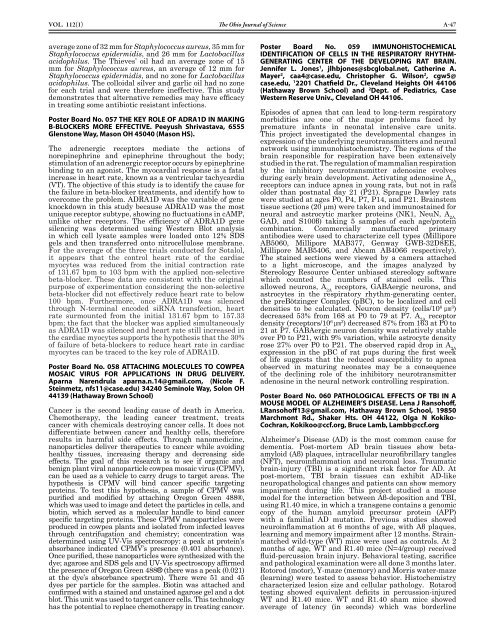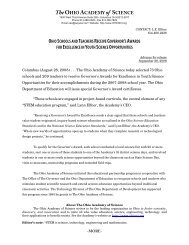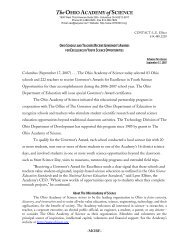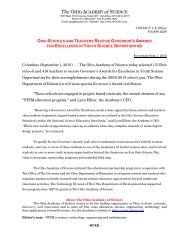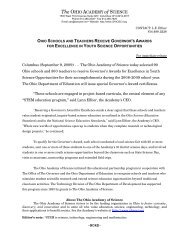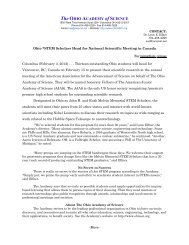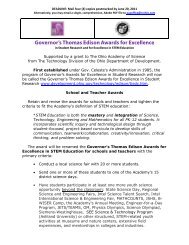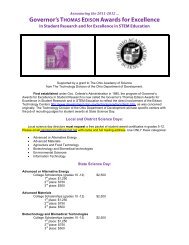The Ohio Journal of - The Ohio Academy of Science
The Ohio Journal of - The Ohio Academy of Science
The Ohio Journal of - The Ohio Academy of Science
You also want an ePaper? Increase the reach of your titles
YUMPU automatically turns print PDFs into web optimized ePapers that Google loves.
Vol. 112(1)<br />
average zone <strong>of</strong> 32 mm for Staphylococcus aureus, 35 mm for<br />
Staphylococcus epidermidis, and 26 mm for Lactobacillus<br />
acidophilus. <strong>The</strong> Thieves’ oil had an average zone <strong>of</strong> 15<br />
mm for Staphylococcus aureus, an average <strong>of</strong> 12 mm for<br />
Staphylococcus epidermidis, and no zone for Lactobacillus<br />
acidophilus. <strong>The</strong> colloidal silver and garlic oil had no zone<br />
for each trial and were therefore ineffective. This study<br />
demonstrates that alternative remedies may have efficacy<br />
in treating some antibiotic resistant infections.<br />
Poster Board No. 057 THE KEY ROLE OF ADRA1D IN MAKING<br />
B-BLOCKERS MORE EFFECTIVE. Peeyush Shrivastava, 6555<br />
Glenstone Way, Mason OH 45040 (Mason HS).<br />
<strong>The</strong> adrenergic receptors mediate the actions <strong>of</strong><br />
norepinephrine and epinephrine throughout the body;<br />
stimulation <strong>of</strong> an adrenergic receptor occurs by epinephrine<br />
binding to an agonist. <strong>The</strong> myocardial response is a fatal<br />
increase in heart rate, known as a ventricular tachycardia<br />
(VT). <strong>The</strong> objective <strong>of</strong> this study is to identify the cause for<br />
the failure in beta-blocker treatments, and identify how to<br />
overcome the problem. ADRA1D was the variable <strong>of</strong> gene<br />
knockdown in this study because ADRA1D was the most<br />
unique receptor subtype, showing no fluctuations in cAMP,<br />
unlike other receptors. <strong>The</strong> efficiency <strong>of</strong> ADRA1D gene<br />
silencing was determined using Western Blot analysis<br />
in which cell lysate samples were loaded onto 12% SDS<br />
gels and then transferred onto nitrocellulose membrane.<br />
For the average <strong>of</strong> the three trials conducted for Sotalol,<br />
it appears that the control heart rate <strong>of</strong> the cardiac<br />
myocytes was reduced from the initial contraction rate<br />
<strong>of</strong> 131.67 bpm to 103 bpm with the applied non-selective<br />
beta-blocker. <strong>The</strong>se data are consistent with the original<br />
purpose <strong>of</strong> experimentation considering the non-selective<br />
beta-blocker did not effectively reduce heart rate to below<br />
100 bpm. Furthermore, once ADRA1D was silenced<br />
through N-terminal encoded siRNA transfection, heart<br />
rate surmounted from the initial 131.67 bpm to 157.33<br />
bpm; the fact that the blocker was applied simultaneously<br />
as ADRA1D was silenced and heart rate still increased in<br />
the cardiac myocytes supports the hypothesis that the 30%<br />
<strong>of</strong> failure <strong>of</strong> beta-blockers to reduce heart rate in cardiac<br />
myocytes can be traced to the key role <strong>of</strong> ADRA1D.<br />
Poster Board No. 058 ATTACHING MOLECULES TO COWPEA<br />
MOSAIC VIRUS FOR APPLICATIONS IN DRUG DELIVERY.<br />
Aparna Narendrula aparna.n.14@gmail.com, (Nicole F.<br />
Steinmetz, nfs11@case.edu) 34240 Seminole Way, Solon OH<br />
44139 (Hathaway Brown School)<br />
Cancer is the second leading cause <strong>of</strong> death in America.<br />
Chemotherapy, the leading cancer treatment, treats<br />
cancer with chemicals destroying cancer cells. It does not<br />
differentiate between cancer and healthy cells, therefore<br />
results in harmful side effects. Through nanomedicine,<br />
nanoparticles deliver therapeutics to cancer while avoiding<br />
healthy tissues, increasing therapy and decreasing side<br />
effects. <strong>The</strong> goal <strong>of</strong> this research is to see if organic and<br />
benign plant viral nanoparticle cowpea mosaic virus (CPMV),<br />
can be used as a vehicle to carry drugs to target areas. <strong>The</strong><br />
hypothesis is CPMV will bind cancer specific targeting<br />
proteins. To test this hypothesis, a sample <strong>of</strong> CPMV was<br />
purified and modified by attaching Oregon Green 488®,<br />
which was used to image and detect the particles in cells, and<br />
biotin, which served as a molecular handle to bind cancer<br />
specific targeting proteins. <strong>The</strong>se CPMV nanoparticles were<br />
produced in cowpea plants and isolated from infected leaves<br />
through centrifugation and chemistry; concentration was<br />
determined using UV-Vis spectroscropy: a peak at protein’s<br />
absorbance indicated CPMV’s presence (0.401 absorbance).<br />
Once purified, these nanoparticles were synthesized with the<br />
dye; agarose and SDS gels and UV-Vis spectroscopy affirmed<br />
the presence <strong>of</strong> Oregon Green 488® (there was a peak (0.021)<br />
at the dye’s absorbance spectrum). <strong>The</strong>re were 51 and 45<br />
dyes per particle for the samples. Biotin was attached and<br />
confirmed with a stained and unstained agarose gel and a dot<br />
blot. This unit was used to target cancer cells. This technology<br />
has the potential to replace chemotherapy in treating cancer.<br />
<strong>The</strong> <strong>Ohio</strong> <strong>Journal</strong> <strong>of</strong> <strong>Science</strong> A-47<br />
Poster Board No. 059 IMMUNOHISTOCHEMICAL<br />
IDENTIFICATION OF CELLS IN THE RESPIRATORY RHYTHM-<br />
GENERATING CENTER OF THE DEVELOPING RAT BRAIN.<br />
Jennifer L. Jones 1 , jlhbjones@sbcglobal.net, Catherine A.<br />
Mayer 2 , caa4@case.edu, Christopher G. Wilson 2 , cgw5@<br />
case.edu, 1 2201 Chatfield Dr., Cleveland Heights OH 44106<br />
(Hathaway Brown School) and 2 Dept. <strong>of</strong> Pediatrics, Case<br />
Western Reserve Univ., Cleveland OH 44106.<br />
Episodes <strong>of</strong> apnea that can lead to long-term respiratory<br />
morbidities are one <strong>of</strong> the major problems faced by<br />
premature infants in neonatal intensive care units.<br />
This project investigated the developmental changes in<br />
expression <strong>of</strong> the underlying neurotransmitters and neural<br />
network using immunohistochemistry. <strong>The</strong> regions <strong>of</strong> the<br />
brain responsible for respiration have been extensively<br />
studied in the rat. <strong>The</strong> regulation <strong>of</strong> mammalian respiration<br />
by the inhibitory neurotransmitter adenosine evolves<br />
during early brain development. Activating adenosine A 2A<br />
receptors can induce apnea in young rats, but not in rats<br />
older than postnatal day 21 (P21). Sprague Dawley rats<br />
were studied at ages P0, P4, P7, P14, and P21. Brainstem<br />
tissue sections (20 µm) were taken and immunostained for<br />
neural and astrocytic marker proteins (NK1, NeuN, A 2A,<br />
GAD, and S100β) taking 5 samples <strong>of</strong> each age/protein<br />
combination. Commercially manufactured primary<br />
antibodies were used to characterize cell types (Millipore<br />
AB5060, Millipore MAB377, Genway GWB-32D8EE,<br />
Millipore MAB5406, and Abcam AB4066 respectively).<br />
<strong>The</strong> stained sections were viewed by a camera attached<br />
to a light microscope, and the images analyzed by<br />
Stereology Resource Center unbiased stereology s<strong>of</strong>tware<br />
which counted the numbers <strong>of</strong> stained cells. This<br />
allowed neurons, A 2A receptors, GABAergic neurons, and<br />
astrocytes in the respiratory rhythm-generating center,<br />
the preBötzinger Complex (pBC), to be localized and cell<br />
densities to be calculated. Neuron density (cells/10 6 µm 3 )<br />
decreased 53% from 168 at P0 to 79 at P7. A 2A receptor<br />
density (receptors/10 6 µm 3 ) decreased 87% from 163 at P0 to<br />
21 at P7. GABAergic neuron density was relatively stable<br />
over P0 to P21, with 9% variation, while astrocyte density<br />
rose 27% over P0 to P21. <strong>The</strong> observed rapid drop in A 2A<br />
expression in the pBC <strong>of</strong> rat pups during the first week<br />
<strong>of</strong> life suggests that the reduced susceptibility to apnea<br />
observed in maturing neonates may be a consequence<br />
<strong>of</strong> the declining role <strong>of</strong> the inhibitory neurotransmitter<br />
adenosine in the neural network controlling respiration.<br />
Poster Board No. 060 PATHOLOGICAL EFFECTS OF TBI IN A<br />
MOUSE MODEL OF ALzHEIMER’S DISEASE. Lena J Ransoh<strong>of</strong>f,<br />
LRansoh<strong>of</strong>f13@gmail.com, Hathaway Brown School, 19850<br />
Marchmont Rd., Shaker Hts. OH 44122, Olga N Kokiko-<br />
Cochran, Kokikoo@ccf.org, Bruce Lamb, Lambb@ccf.org<br />
Alzheimer’s Disease (AD) is the most common cause for<br />
dementia. Post-mortem AD brain tissues show betaamyloid<br />
(Aβ) plaques, intracellular neur<strong>of</strong>ibrillary tangles<br />
(NFT), neuroinflammation and neuronal loss. Traumatic<br />
brain-injury (TBI) is a significant risk factor for AD. At<br />
post-mortem, TBI brain tissues can exhibit AD-like<br />
neuropathological changes and patients can show memory<br />
impairment during life. This project studied a mouse<br />
model for the interaction between Aβ-deposition and TBI,<br />
using R1.40 mice, in which a transgene contains a genomic<br />
copy <strong>of</strong> the human amyloid precursor protein (APP)<br />
with a familial AD mutation. Previous studies showed<br />
neuroinflammation at 6 months <strong>of</strong> age, with Aβ plaques,<br />
learning and memory impairment after 12 months. Strainmatched<br />
wild-type (WT) mice were used as controls. At 2<br />
months <strong>of</strong> age, WT and R1.40 mice (N=4/group) received<br />
fluid-percussion brain injury. Behavioral testing, sacrifice<br />
and pathological examination were all done 3 months later.<br />
Rotorod (motor), Y-maze (memory) and Morris water-maze<br />
(learning) were tested to assess behavior. Histochemistry<br />
characterized lesion size and cellular pathology. Rotarod<br />
testing showed equivalent deficits in percussion-injured<br />
WT and R1.40 mice. WT and R1.40 sham mice showed<br />
average <strong>of</strong> latency (in seconds) which was borderline


